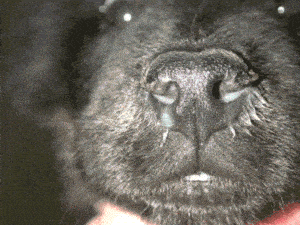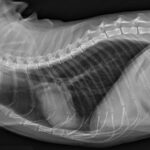Distemper is a viral disease in dogs that is characterized by fever, neurological signs,

respiratory signs as well as crusting paw pads and vomiting. While these symptoms often occur in phases, sometimes not all the symptoms are seen so to the owner, the published phases don’t always fit what is expected and owners think their pet was misdiagnosed or may have recovered. If only it was that simple!
In general, dogs that are unvaccinated or going through their puppy series are most susceptible. When a fever is coupled with neurologic symptoms like head twitching and respiratory disease, distemper virus should be considered.
When seen, symptoms usually begin with:
- Gooey eye and nose discharge
- Fever, which often comes and goes unnoticed
- Poor appetite
- Coughing and development of pneumonia
The virus is attacking interfaces of the body with the environment (the mucous membranes) and starts with the respiratory tract, hence the pneumonia, but it does not stop there. The virus moves on to produce:
- Vomiting and diarrhea
- Callusing of the nose and foot pads (hence one of the old names for distemper – hard pad disease).
After completing what is called the mucosal phase of infection where environmental interfaces are attacked (as described by the above GI and respiratory disease), the virus proceeds to the central nervous system for its neurologic phase leading to:
- Seizures, classically starting with snapping or tremors of the jaws that progress to convulsions of the whole body. This distemper classic sign is called a chewing gum fit.
- Seizures are not the only distemper sign by any means. Tremors, imbalance, and limb weakness all may occur. Signs may progress to death or may become non-progressive and permanent. Recovery is also possible.
Older stronger puppies / dogs can clear the respiratory or mucosal phase and seem to improve. Some may have symptoms so mild that they go unnoticed. So, dog appears to recover only to break with neurologic disease 1 to 3 weeks later.
Younger puppies or individuals with weak immunity often die during the mucosal phase. Stronger dogs may not appear ill until the neurologic phase strikes.
The Virus
The infected dog typically infects other dogs via coughing infected respiratory secretions though the virus is shed in most other body secretions, including urine. The virus enters the new host via the nose or mouth and promptly begins to replicate.
The virus is engulfed by cells of the immune system in a cell line called Macrophages. The virus is able to use the macrophage as a means of transportation through the host’s body. Within 24 hours, the virus has traveled to the lymph nodes of the lung. By the 6th day, the virus has migrated to the spleen, stomach, small intestine, and liver. At this point, dogs often have a fever.
Transmission and Infection
In stronger pups, as the host’s immune response grows symptoms wane. This phenomenon accounts for the wide variability in symptoms; some dogs get only a few mild symptoms while others get a full lethal combination.
After clearing from most internal organs, the virus is able to hide out for long periods of time in the nervous system and skin. Because of this phenomenon, callusing of skin or – much worse – seizures may occur long after the infection was thought to be cleared.
Most cases in the U.S. involve puppies. The colostrum suckled in the first day or so of life will provide them with a solid reflection of their mother’s immunity if the mother was properly vaccinated. This immunity will have waned by age 16 weeks or sooner, leaving the puppy vulnerable if vaccines have not been administered.
Confirming the Distemper Infection
As if it is not bad enough that this infection has a poorly defined endpoint so you never know for sure if the dog is out of the woods, it is almost impossible to confirm a distemper diagnosis. Because of this, distemper is a clinical diagnosis, which means that rather than confirming infection with a test that is negative or positive, the veterinarian must look at the whole picture: what symptoms are there, is the history typical, etc. The virus itself remains elusive so that positive test results are meaningful in confirming the infection, but negative results do not rule it out. The following are tests that can be used.
Distemper Inclusion Bodies – seen microscopically
Distemper Antibody Levels – measured from the serum portion of the blood
PCR Testing – DNA amplification of the virus
The problem with the above tests is if the puppy is in the process of getting vaccinated, it may test positive for all the above tests as the vaccine is a very weakened but live variation of the actual virus. So testing a puppy that has been vaccinated within 2 weeks can result in a positive test. It is difficult to know if this is the result of the vaccination versus the actual virus.
Cerebrospinal Fluid Antibody Levels
In neurologic distemper cases, cerebrospinal fluid is often tapped and distemper antibody levels checked. Distemper antibodies in cerebrospinal fluid are highly indicative of distemper infection as vaccine-induced antibodies do not cross the blood-brain barrier into the CSF fluid.
Treatment for Distemper
Many bizarre protocols have emerged over time as we grope for meaningful anti-viral therapy. The fact remains that recovery from distemper is all about immunity and the only real treatment is supportive care while the patient mounts an immune response. If the patient has pneumonia, antibiotics are used on the secondary bacterial infections. Airway dilators are used as needed. Physical therapy is used to promote coughing. If the patient has diarrhea, intravenous fluids are used to prevent dehydration.
Distemper is extremely variable in its ability to produce symptoms and recovery occurs at any stage. This has led to assorted therapies being credited with effect when what was more likely witnessed was the natural removal of the infection by the host’s immune system.
Neurologic distemper is particularly difficult to treat. Still, it is possible for dogs to recover with livable deficits even from neurodistemper; euthanasia is best left for progressive, incapacitating neurologic symptoms.
Preventing Infection
Today’s “distemper” vaccination, which also usually incluses prevention for parvovirus, a hepatitis virus and parainfluenza, immunizes a dog so by the time they’re 16-18 weeks of age, they should be protected. Vaccinations should be started at 6-8 weeks of age and vaccines should be boostered every 2-4 weeks until 16-20 weeks of age. After this, the next booster is in one year followed by every three years.
Today in the US, there is no excuse to not vaccinate puppies and prevent this preventable disease. Preventative care is essential for dogs just as small pox, measles, mumps and rubella is needed in people.
How long is a recovered dog contagious?
A recovered dog may shed virus up to 2 to 3 months. It is important to keep this in mind when taking a recovered pet anywhere where there are other dogs. The most intense viral shedding occurs in the first 2 weeks of infection.
Vet Hospital in Houston Heights
Urban Animal Veterinary Hospital
1327 Yale St
Houston, TX 77008
(713) 863-008


